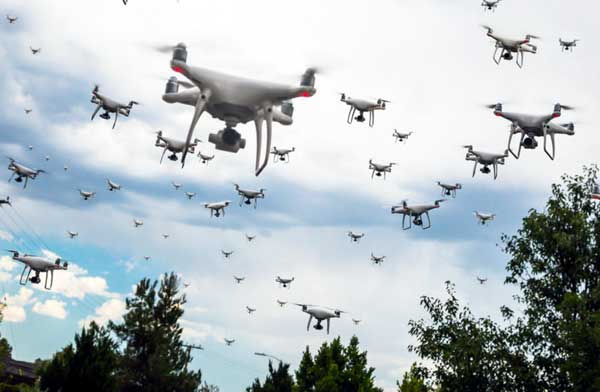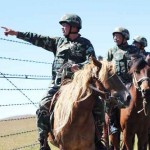
“I visualize a time when we will be to robots what dogs are to humans, and I’m rooting for the machines.” — Claude Shannon
The fourth industrial revolution has brought forth the evolution of disruptive technologies which in years to come will change the nature of future warfighting. The call of the swarms is set to storm the future battlefields. The evolution of this technology has its roots in the of a flock of birds. The ‘Murmuration of Starlings’ in the UK is an apt demonstration of the exchange of intelligence by thousands of Starlings flying in unison and creating formations. The utilisation of the third dimension especially at the operational and the tactical level would change the way battles are fought. Drone swarms are here and are coming to a battlefield soon, and it is time to address how best to employ them.
Swarm Technology
Swarm or fleet of Unmanned Aerial Vehicles (UAVs) is a set of aerial robots i.e., drones that work together to achieve a specific goal. Each drone in a swarm is propelled by a specific number of rotors and has the ability to vertically hover, take-off, and land (VTOL). The flight of the drone swarms is controlled either manually, i.e. by remote control operations (semi-autonomous), or autonomously by using processors deployed on the drones. The drones can communicate with each other and are programmed with AI-enabled algorithms. The swarm drones provide real-time situational awareness by enhancing the widespread ISR capabilities. They possess a unique battle-winning factor of surveillance and targeting on a single platform. Aerial drone swarms provide tremendous advantages in the battlefield to include provisioning of a common operating picture, real-time decision making to the leaders, precision targeting, the mass swarming with speed and lethality has a psychological dislocation of the enemy, it also increases the sensitivity of the leaders by reduction of casualties and the most critical part is it is cheap. The challenges faced by this technology are electronic, cyber threat (hacking), ethical, and legal constraints.
Global Trends
USA, Russia, and China are currently the leaders in the development of swarm technology, the tests, especially in the US, have displayed behaviors such as collective decision-making, adaptive formation flying, and self-healing. The cheap cost, accessibility, and ease of operation have allowed non-state actors to employ them in various innovative ways, thereby posing a new challenge to National Security.
USA
DARPA (Defense Advanced Research Project Agency) is developing a number of projects in this field, the Offensive Swarm Enabled Tactics (OFFSET) program designed for Infantry units has a capability of utilising 250 drones has been tested. The Squad X program allows soldiers to collect information in the field with AI-enabled drones and ground robots. The prototypes have been fielded in the 82 Airborne Division. The Low-Cost UAV Swarming Technology (LOCUST) is developed for the US Navy are a swarm of drones that can jam enemy communications, and waste enemy resources by drawing fire. The launchers are capable of tube-launching 31 drones in just 40 seconds. The drones can fly autonomously but can also be controlled manually. At just $15,000 a unit, the drones are expendable and can be used in threatening situations. LOCUS is now in its development and testing phase. The Gremlin project is a set of Swarm drones that can be dropped from the aircraft are micro-drones that can carry out surveillance and execute precision strikes.
China
Realising the disruptive potential of new technologies China has been developing swarm technologies. Recently China demonstrated the launch of over 200 swarm drones from a 48-tube launcher and from a helicopter, the drones during the tests switched between different formations and conducted reconnaissance and attack missions on ground targets.
Russia
In Sep 2020, the Russian military conducted large-scale annual exercises in Russia’s Southern Military District called Kavkaz-2020. Kavkaz-2020 was anything but routine, the exercises demonstrated for the first time that Russia has a capability to use mass drone warfare in conjunction with its massive conventional power for offensive operations. The exercises employed the mass use of a swarm of drones to target and assist in the destruction of enemy forces (“terrorists,” according to the Russian Ministry of Defense). At least three models of drones—Forpost, Orlan-10, and Eleron-3—were employed together on the Kapustin Yar testing range.
Non-State Actors
Non-state actors like Hezbollah, Hamas, and ISIS are pursuing the use of drone swarms for purposes of attack and ISR. The successful strikes by a swarm of drones on the Saudi Oilfields on 14 Sep 2019 by suspected Houthi extremists and attempted attack on Russian, Khmeimim airbase in Western Syria in 2018 are facts of the changing nature of hybrid warfare. The use of cheap and lethal technologies by the non-state actors has increased the threat to National Security manifolds.
Lessons for India
Indian army faces enormous challenges in the form of two and a half fronts, while the nexus of Pakistan and China will ensure niche military disruptive technologies being employed along both fronts, the employment of these cheap tools by the non-state actors cannot be ruled out. To counter the threat it is prudent that the Indian Army enhances its capabilities by inducting swarm technologies. This niche disruptive technology has scope for employment in all operations of war and in all terrains. The current focus is on surveillance and targeting by standalone drones. There is a need for analysing the development of swarm drones to give a boost to the fighting potential of the Indian Army.
Counter Infiltration/Terrorist Operations
It’s been decades that the security forces have been combating this asymmetric threat enduring harsh weather and terrain conditions. The network of swarms along the challenging Line of Control will assist the security forces in detecting the terrorist infiltrating groups but also neutralise them with pinpoint precision thereby reducing the possibilities of casualties for security forces, and gaining tremendous moral ascendancy. The detection and neutralisation of terrorists in the hinterland be it thick jungles or built-up areas will not only avoid collateral damage but also help reducing terrorism. The technology which is AI-enabled can also be used in crowd control and in the anti-riot role by the paramilitary and State Police
Conventional Conflict
The world over this technology is being developed to give an edge in conventional conflicts. The employment of swarm drones especially in offensive operations along the Northern Borders will be a game-changer. The overwhelming aerial shock effect by the swarms with precision will turn the tide for the attacker in high altitude areas.
Way Ahead
The simplicity of the design and the complexity of the technology can be harnessed as the country has the required technical expertise to develop them. The leading companies in the world have employed Indians as data scientists and AI experts who are developing the software behind these lethal machines. The low cost of development of this niche technology is perhaps the lowest hanging fruit which the Indian Army should harness immediately by encouraging indigenous private industries to develop the technology. The sector-specific models for procurement could be adopted to suit the operational requirement. This technology could easily be developed through public-private partnerships. The current DAP-2020 provides immense scope for indigenous development of such technologies indigenously thus giving a boost to the ‘Atmanirbhar Bharat’ campaign.
Conclusion
The drone swarm narrative no longer resides in science fiction. The books like Ghost Fleet and movies such as Angel has Fallen and Star Trek is now a reality. The extensive employment of these technologies is being used to exert power in the geopolitical domain and it is not too late to start focussing on emerging technologies.
The employment of swarm drones have the potential to be a game-changer at operational and tactical levels in future wars and we must build capacities to embrace them.
End Notes
How swarming drones will change warfare, Thomas Mc Mullan dt 16 March 2019 https://www.bbc.com/news/technology-47555588
Swarms of unmanned vehicles, A survey. Dec 2019 https://www.sciencedirect.com/science/article/pii/S2452414X18300086
Drone Swarms by Maj Andrew Dec 2017. Publication of Command and General Staff College, USA.
Watch DARPA test a Swarm of drones by Jay Peters, Aug 2019. https://www.theverge.com/2019/8/9/20799148/darpa-drones-robots-swarm-military-test.
Are Swarms the future of aerial warfare by Micheal Safi, Dec 2019 https://www.theguardian.com/news/2019/dec/04/are-drone-swarms-the-future-of-aerial-warfare.
China unveils first practical drone swarm tech. https://www.globaltimes.cn/content/1203857.shtml
Swarms over Kamkaz by Joe warner dt 27 Oct 2020 https://mwi.usma.edu/swarms-over-kavkaz
Courtesy: https://www.claws.in/storm-of-the-swarms-lessons-for-india/




